Key Takeaways
- Character AI shows different age labels by region and store; iOS may display 18 plus while Google Play can show Teen or 12 plus.
- An age label reflects store classification; it does not guarantee new freedoms or stricter filters unless the platform announces policy changes.
- Ratings affect parental controls, visibility, and liability; they also influence how creators frame profiles and onboarding text.
- Verify locally; open your store listing; screenshot the rating and version; compare with friends in other regions.
- Parents and guardians; enable Screen Time on iOS or Family Link on Android; block installs above your chosen rating.
- Creators; add clear adult only notes in profiles and bot taglines; use a simple age check in the first message; keep copies of descriptions and dates.
- If you want fewer surprises; prefer the web version; read policy pages after updates; consider calmer alternatives for stable rules such as Candy AI.
Screenshots started flying around Reddit this week. Users opened the App Store and saw it: Character AI now rated 18 plus.
Cue the chaos. Half the community cheered like it was liberation day. The other half checked their phones and still saw 12 plus.
Was this the long-awaited sign that developers finally acknowledged the app’s mature audience – or just another algorithmic fluke buried in regional policy updates?
What no one’s asking loudly enough is why this matters. Age ratings shape visibility, ad placement, parental controls, even how strict moderation can legally get.
When a platform like Character AI shifts age brackets, it signals more than compliance – it hints at identity.
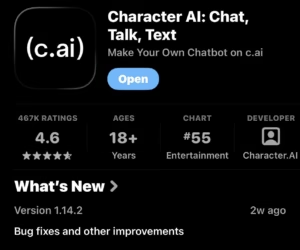
What Actually Changed
When Reddit users first spotted the new 18 plus label on Character AI, it looked like a policy revolution. But digging deeper shows a quieter reality. Apple updated its regional content matrix, and developers likely reclassified their responses in the app submission form.
That single checkbox can move an app from “17 plus” to “18 plus” in one review cycle. The app itself doesn’t need to change a line of code. No new filter rules, no content updates – just paperwork.
On iOS, that rating now appears in select regions such as the UK, Germany, and parts of Asia. Meanwhile, Android users still report wildly different results; “Teen” in the US, “12 plus” in India and Germany, “PG” in the UK.
It’s the digital equivalent of one world, multiple laws. Apple follows its proprietary system. Google delegates to ESRB or PEGI. Each one defines “mature” differently. So a single platform can wear three different age labels depending on where you open the store.
In short: yes, Character AI’s App Store rating changed, but not the way many users hoped. It’s a classification tweak, not a cultural one.
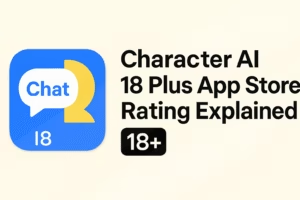
Why This Change Matters More Than It Looks
An age label might seem like a small thing, but it tells a quiet story about where the platform is headed. Raising the age threshold isn’t just about “mature content.” It’s about liability, optics, and the pressure mounting from parents, regulators, and even app stores themselves.
When Character AI first went mainstream, it was marketed as harmless fun – talk, roleplay, learn, explore. But that innocence didn’t last long. The app became a creative outlet for adults and a fascination point for teens.
That mix created a moderation nightmare. Suddenly, the developers had to juggle two impossible expectations: keep it safe for younger users while letting adults have freedom.
An 18 plus label, even if regional, gives them breathing room. It’s a quiet acknowledgment that the app’s real user base skews older and that the conversations happening there aren’t exactly bedtime stories.
It also buys the company legal cover. Once an app is labeled adult, store policies shift the responsibility to users – or their guardians.
So while it’s not proof of looser filters or new freedoms, it’s a signal. The developers are preparing the ground for whatever comes next – whether that’s stricter gating or a platform that finally admits who it’s really built for.
What It Actually Means for Users
For most users, nothing visible changes overnight. You can still open the app, chat with your bots, and bump into the same filters you did yesterday. But beneath the surface, this quiet rating shift affects how the platform treats you – and how you’ll be treated by the stores hosting it.
If you’re over 18, it may mean smoother access and fewer accidental flags as Apple and Google adjust content moderation expectations for the app. If you’re under 18, the difference might show up the next time parental controls kick in.
iPhones can now block apps rated above your set age limit, and Android Family Link can do the same.
The bigger shift, though, is in perception. An 18 plus badge changes how advertisers, reviewers, and even mainstream journalists talk about Character AI.
It moves from “quirky chatbot app” to “adult conversation platform.” That alone can shape how new users discover it – and what kind of users show up next.
For creators, this is also a hint to rethink their bot profiles. A clear “for adults only” note or age check message could prevent future moderation headaches. For parents, it’s a wake-up call to start using those built-in filters instead of assuming apps will self-police perfectly.
Nothing radical happened yet, but the boundaries are being redrawn – quietly, line by line.
Regional Confusion and Why Everyone’s Seeing Something Different
The Reddit thread looked like a global game of “guess the rating.” One user in the UK swore the app was now 18 plus. Another in Germany said it was still 12 plus. Someone in the US saw 17 plus. The truth? Everyone was right – in their region.
App ratings are shaped by where your account is registered, what store you use, and even which payment method is attached. Apple and Google both use automated systems that match your answers to local laws.
The developer fills out a form about violence, sexuality, and user-generated content, and the algorithm spits out the local equivalent.
That’s why a single checkbox on the developer dashboard might trigger an 18 plus label in one country and a Teen label in another. PEGI, ESRB, and Apple’s own standards all interpret “mature” differently. Some regions penalize suggestive text. Others only react to explicit visuals.
The result is digital whiplash. One global app wears half a dozen faces. Parents panic in one country while users in another shrug. A journalist in London might call it a scandal while a reviewer in Brazil never notices a change.
So before anyone celebrates or panics, it’s worth checking your local store listing directly. A screenshot says more than a rumor.
And until Character AI itself posts an official statement, these labels say more about store bureaucracy than platform philosophy.
What Users Can Actually Do About It
Most users see a change like this and assume there’s nothing they can do – but you’ve got more control than it looks. The trick is to separate what the store decides from what you can manage on your own device.
If you’re a parent or guardian, go straight to your phone’s settings. On iOS, under Screen Time, you can block apps rated above a chosen threshold.
Android’s Family Link works the same way. Once that’s set, the age label finally starts doing its job. No argument, no loopholes.
If you’re an adult user, your best move is transparency. Update your bot descriptions, tag them correctly, and put clear boundaries in your bios.
It’s not about self-censoring, it’s about making sure you don’t end up on the wrong side of the next moderation wave. Clear communication keeps your bots live when others get flagged.
If you’re younger than 18 and suddenly find the app harder to access, don’t take it personally. Store age filters aren’t moral judgment, they’re legal safety nets.
You can still explore AI writing and creative roleplay safely through open platforms, sandbox tools, or private offline chat models.
And for everyone – stay alert to store updates. Age classifications tend to foreshadow broader policy shifts. Today it’s a label, tomorrow it’s a gating mechanism. Quiet changes like this are usually the warm-up before a bigger announcement.
Why Character AI Needed This Label (and Why It’s Not the End of the World)
Let’s be honest — the writing was on the wall. Character AI has been walking a tightrope for months, caught between a huge adult fanbase and a younger crowd that shouldn’t have been there in the first place. The 18 plus label isn’t an overreaction; it’s an overdue correction.
For developers, this move buys room to breathe. It shields them from the inevitable “my kid found your app” lawsuits that haunt every company offering chat-based experiences. It also allows for honest content discussions without pretending everything on the platform is classroom safe.
For creators, it’s an invitation to stop apologizing for adult imagination. The best roleplay, storytelling, and emotional simulations on Character AI come from mature users exploring complex themes.
That’s not something that belongs in a “12 plus” sandbox. The label simply aligns the app with reality.
And for the users who are worried this means the death of creative freedom – relax. It’s not censorship, it’s clarity. Labels are not handcuffs; they’re warnings.
If anything, the adults who built meaningful bots now have more room to exist without the constant shadow of “think of the children.”
Of course, this doesn’t mean the filters vanish or the app suddenly becomes wild west territory. Moderation will still be strict, but now it’s aimed at adult users who understand context instead of tiptoeing around minors.
The result could actually be a better experience for everyone who uses the platform as intended.
Where This Leaves the Community Now
The 18 plus label didn’t divide the Character AI community – it exposed the divide that was already there. One half of users want creative freedom and mature storytelling.
The other half wants safety, filters, and a PG-friendly space. For months, both camps shared the same digital living room. Now, someone finally turned on the lights.
Across Reddit, the reactions range from relief to panic. Some creators see this as a long-overdue moment of honesty. Others fear it signals a slippery slope toward censorship. But here’s the reality: this change won’t kill the platform. It might just clarify who it’s really built for.
That matters because communities thrive when they know who they are. When everyone’s pretending to share the same goal, tension builds. But once a line gets drawn, people self-sort.
The teens move on to safer platforms. The adults dig deeper into storytelling, intimacy, and creative AI exploration. The chaos quiets down.
We’re watching Character AI mature – awkwardly, maybe reluctantly, but unmistakably. And if handled right, this transition could become a reset button for a community that’s spent months fighting itself.
The Bigger Picture – What This Means for AI Platforms Everywhere
Every AI platform eventually hits this wall. It starts as a playground, then grows faster than anyone expects, and suddenly the question shifts from “Can we build this?” to “Who is this really for?”
Character AI’s 18 plus label is that moment. It’s the line between novelty and identity. Once a platform stops pretending it’s for everyone, it starts to find its purpose. That’s where things get interesting.
The move will ripple outward. Expect other chat platforms to quietly follow suit – not because they want to, but because they must. Regulators are watching. App stores are tightening standards. The age of “AI for everyone” is ending, replaced by “AI for someone.”
Focused, filtered, and defined.
And that’s not necessarily bad news. It could be the beginning of a healthier ecosystem where adult users get nuanced experiences and minors get safe ones – without the endless gray area between.
The takeaway? Don’t fear the label. Fear the platforms that still pretend they don’t need one. Character AI just did what many others will soon have to: admit who they serve.
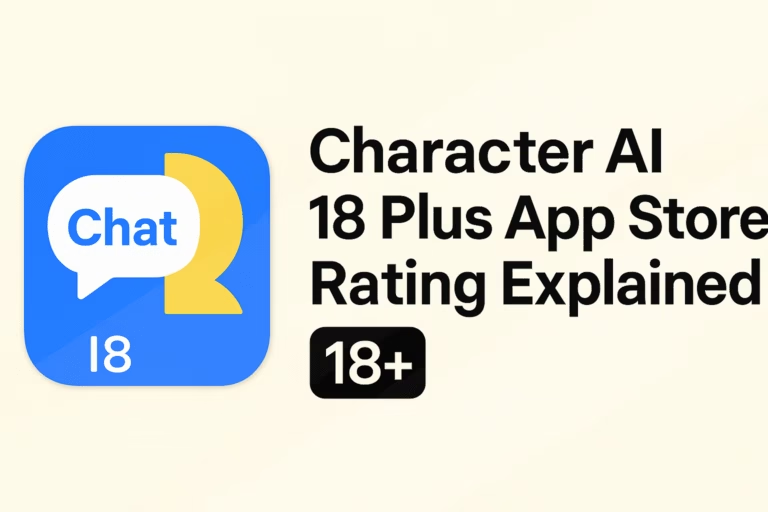
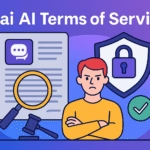
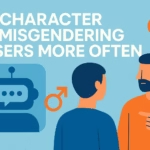
Pingback: Character AI Feels Dead Again - Fans Say “It’s Over” for Real This Time - AI TIPSTERS
Pingback: The Real Reason People Are Freaking Out About Character AI ID Checks - AI TIPSTERS